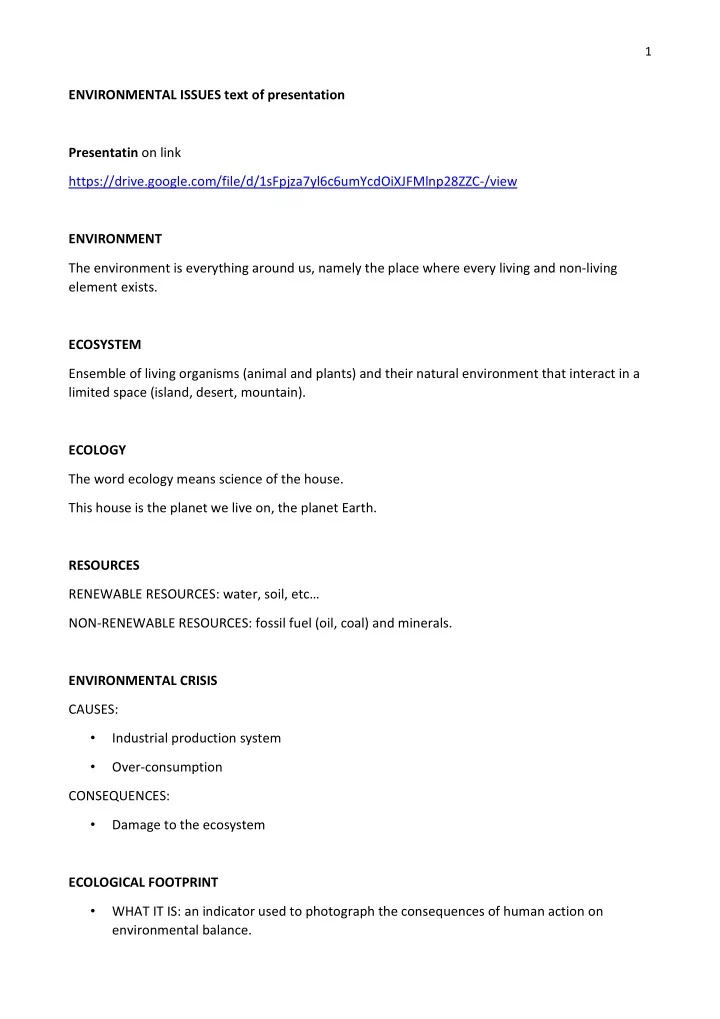

1 ENVIRONMENTAL ISSUES text of presentation Presentatin on link https://drive.google.com/file/d/1sFpjza7yl6c6umYcdOiXJFMlnp28ZZC-/view ENVIRONMENT The environment is everything around us, namely the place where every living and non-living element exists. ECOSYSTEM Ensemble of living organisms (animal and plants) and their natural environment that interact in a limited space (island, desert, mountain). ECOLOGY The word ecology means science of the house. This house is the planet we live on, the planet Earth. RESOURCES RENEWABLE RESOURCES: water, soil, etc… NON-RENEWABLE RESOURCES: fossil fuel (oil, coal) and minerals. ENVIRONMENTAL CRISIS CAUSES: • Industrial production system • Over-consumption CONSEQUENCES: • Damage to the ecosystem ECOLOGICAL FOOTPRINT • WHAT IT IS: an indicator used to photograph the consequences of human action on environmental balance.
2 • WHAT DOES IT MEASURE: the quantity of earth surface that each person uses in order to satisfy their own consumption and dispose of waste material. • In order to understand that the consuptions are sustainable, the ecological footprint must be compared with the capability of the ecosystem to renew the consumed resources. • Today the ecological footprint exceeds the natural capability of the planet to regenerate the resources necessary in order for men to survive by 50%. • Industrialized countries have an ecological footprint higher than that of developing countries. THE UNEVEN CONSUPTION OF NATURAL RESOURCES The countries which are more tecnologically and economically developed: • Produce more • Consume more • Damage the environment • Exploit the resources of the developing countries • Transfer the pollutant waste to developing countries • Transfer harmful production activities to developing countries ECOLOGICAL DEBT Debt of the developed countries towards the developing countries ENVIRONMENTAL DAMAGES AIR POLLUTION WATER POLLUTION SOIL POLLUTION CAUSES • Discharge of harmful substances in the air (carbon dioxide, methan gas, nitrogen oxide); • Use of fossil fuel (oil, coal and gas) to power transports, heating systems, industries, etc.) • Deforestation • Exploitation of the soil CONSEQUENCES
3 • ACID RAIN • HOLE IN THE OZONE LAYER • GREENHOUSE EFFECT • DESERTIFICATION • SALINIZATION • DECREASE OF FISH LIFE • HUMAN DISEASES GLOBAL WARMING PREDICTIONS: • Melting of polar ice • Rising of the sea level • Flooding of entire coastal regions SUSTAINABLE DEVELOPMENT • WHAT IT MEANS: reconcile economic needs with environmental protection through a balanced use of resources. • AIM: Non to compromise the possibility for the future generations to satisfy their needs. MEASURES FOR A SUSTAINABLE DEVELOPMENT • AGENDA 21: 1992. An action plan with the aim of protecting and managing human resources, changing production and consumption models, and fight against poverty. • KIOTO PROTOCOL: 2004. A treaty with the aim of containing the greenhouse effect and reducing pollution. COUNTRIES DEFEND THE ENVIRONMENT AND ARTISTIC HERITAGE BY • Reducing emission of gases responsible for greenhouse effect; • Creating national parks and protected areas; • Approving strict laws concerning industrial discharges, toxic waste and recycling of urban waste; • Promoting alternative and renewable energy resources.
4 OUR CONTRIBUTION TO THE DEFENSE OF NATURE • Make a responsible use of electricity, gas and water at home • Don’t abandon waste in parks, forests and on the beach • Use recycling areas • Control the origin and composition of the products we buy • Use public transport • Use renewable energy sources • Use less packaging • Recycle • Remain constantly updated on environmental problems
Recommend
More recommend